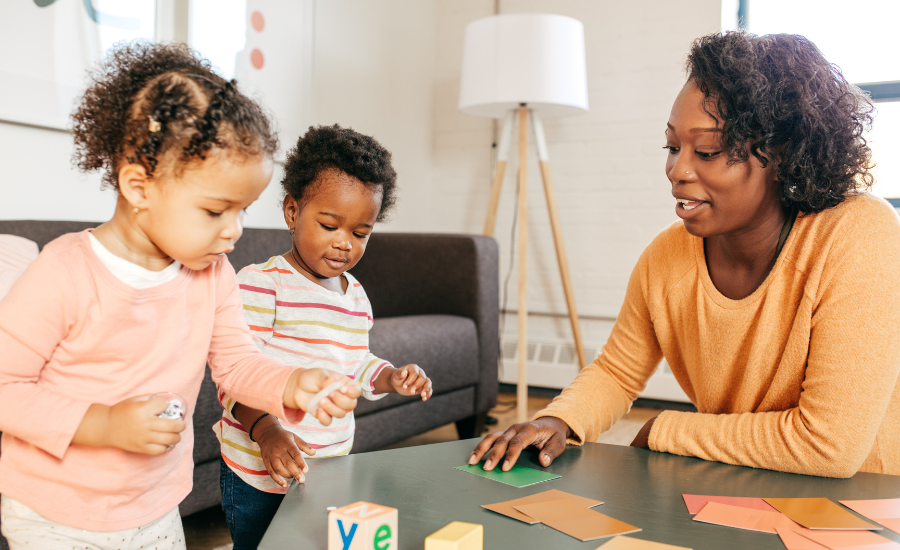How many of your conversations go like this?
“Hi, how —”
“Great, what are you up —”
“Nothing at —”
“I’m hungry, let’s —”
“No, I’m going to —”
“OK bye”
Not many… and the simple reason is not just because it’s awkward, but it’s missing a critical skill we often learn in early childhood – TURN TAKING!
What is Turn-Taking & Why is it Important? From an SLP’s Perspective
Let’s start with the definition of turn-taking, according to the dictionary:
“Turn-taking refers to the process by which people in a conversation decide who is to speak next. It depends on both cultural factors and subtle cues.
- Taking turns; alternating
- An instance of the one participant taking control of some interaction, usually two-party, such as a conversation, from another.”
Turn-taking is important as it teaches us how to have a productive conversation by:
- Recognizing cues when others want to speak
- Not speaking for too long
- Not interrupting others
This skill also lends itself to all aspects of our social lives allowing us to:
- Share resources
- Work together
- Play together
- Exchange ideas
- Be patient
Tips from an SLP for Children that Struggle with Turn-Taking
But it doesn’t come as easy to some children who:
- Don’t have the language to express a desire to take a turn
- Aren’t able to read cues or engage in turn-taking activities
- Struggle with waiting for their turn or giving up their turn
This is where parents, teachers, and therapists can help children understand this concept by using play and games to:
- Model turn-taking skills
- Use direct language to indicate “now it’s your turn”, “now it’s my turn”
- Praise and positive reinforcement “you’re a good listener”, “thank you for waiting your turn”, “great job sharing the ball”
- Watch others or videos to demonstrate and identify signals or opportunities for turn taking
- Roleplaying
Most games typically have clear rules to indicate who’s turn it is. But conversations don’t always have explicit signals, they include more subtle cues that may need to be learned first:
- The tone of voice rises or falls to ask a question
- Pausing
- Eye contact
- Changing facial expressions
- Hand gestures & body positioning
If using GAMES to teach turn-taking skills, keep the rules simple and the pace fast to allow more turns/reduce waiting time. Here are some examples:
- Go Fish
- Uno
- Tic Tac Toe
- Jenga
- Trouble
- Connect 4
Social group activities like Circle Time or Continue the Story often use a talking stick or ball – you might recall this activity from school or camp days 😉
AAC & Turn-Taking
These same principles are applied to those who use augmentative and alternative communication devices (AAC), with a little extra time given to structure and elicit a response.
Because “spontaneous speech is produced at approximately 135 words per minute whereas, with AAC, it can be closer to 10 words per minute.”1
Research has also shown that “although the aided communicator indicated intentions to claim the speaking turn, message delivery could not be initiated during the active period of the turn signals”.2 So, the onus of facilitating turn taking and directing the conversation falls on the unaided speakers, not for lack of attempts by AAC users, but due to the nature of the technology itself and the proficiency level of users.
Technology & Turn-Taking
Therefore, interestingly, low-tech devices such as alphabet spellers, “were able to more easily regulate speaking turns” 2 compared to something more high-tech.
One tip to keep in mind – always ask to clarify at the end: “Do you want to tell me something more?” and wait 45 seconds for a response – this will lead to more meaningful responses as one study found “that participants were more likely to respond to a turn opportunity when their communication partner allowed a longer pause time. Additionally, a longer pause time resulted in a higher MLU.”3
Today, there are many apps and electronic devices available for children of all ages, and these have paved the way for children to engage and communicate in many ways.
Examples of apps that facilitate turn-taking skills include ‘Wipe & Learn’ or ‘Build-It-Up’ that “allow for each child to wipe to reveal a photo or virtually stack a toy”.4 These apps seem to be very intuitive for young children as they go through Piaget’s stages of cognitive development from sensory and motor learning to using symbols to represent objects and ideas.
To learn more about using Apps for language development and tips for SLPs, see: Toddlers and Technology: Teaching the Techniques | The ASHA Leader
And as we head back to school in the coming weeks, consider Tips to Help Teachers Incorporate AAC Into the Classroom (asha.org).
So next time you have a conversation with someone, pause to notice the subtle cues and let them formulate a response to really understand how effective turn-taking is!
REFERENCES:
- https://leader.pubs.asha.org/do/10.1044/2020-1016-aac-awareness/full/
- https://pubmed.ncbi.nlm.nih.gov/2965282/
- https://ir.canterbury.ac.nz/handle/10092/3878
- https://leader.pubs.asha.org/doi/10.1044/leader.ftr5.16112011.np
 Olga Goncharov, M.A, CCC-SLPSpeech-Language Pathologist and Sales Consultant
Olga Goncharov, M.A, CCC-SLPSpeech-Language Pathologist and Sales Consultant
Olga is a Speech and Language Pathologist with over 12 years of experience in the field, specializing in swallow disorders, accent modification, and speech therapy services for adults working to improve overall personal and professional communication skills. Olga received her Bachelor’s degrees in Psychology and Linguistics from the University of Michigan in 2007 and her Masters in Communication Science and Disorders from Wayne State University in 2010.
She has since worked in several states and healthcare settings, currently residing in Northern VA and providing speech therapy services to clients via teletherapy and in acute care at three local hospitals.
